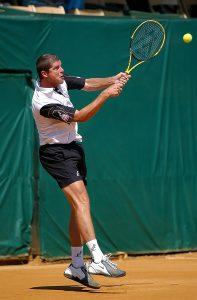We may earn money or products from the companies mentioned in this post.
Introduction

When it comes to playing tennis, having a well-maintained racket can make all the difference One crucial aspect of racket maintenance is regular restringing Restringing your tennis racket not only improves its performance but also helps prevent injuries on the court
Importance of Restringing Tennis Rackets
1 Impact on Performance:
The strings of a tennis racket directly influence how the ball interacts with the racket, affecting shots’ power, control, and spin Over time, strings lose tension and elasticity due to wear and tear, making them less responsive By restringing your racket regularly, you can restore the optimal tension in the strings, allowing for better shot accuracy and overall performance on the court
2 Preventing Injuries:
Worn-out or damaged strings can increase the risk of injury while playing tennis When strings become frayed or lose tension, they may not absorb shock as effectively, putting more strain on your arm and wrist when hitting powerful shots or absorbing impact from fast balls Regularly restringing your racket ensures that you’re playing with equipment that minimizes stress on your body and reduces the chances of developing common tennis-related injuries
Common Questions About Restringing Frequency
1 Factors that Affect String Lifespan:
The lifespan of tennis strings depends on various factors such as frequency of play, playing style (eg, aggressive baseliner vs finesse player), type of string material used (eg, natural gut vs synthetic), and environmental conditions (eg, extreme temperatures). Generally speaking, professional players tend to restring their rackets more frequently than recreational players due to higher intensity gameplay
2 Signs that a Racket Needs Restringing:
There are several indicators that your racket may need restringing Firstly, if you notice significant string movement or shifting during play, it’s a sign that the strings have lost tension and require restringing Additionally, if you’re experiencing a decrease in shot control or power, it could be due to worn-out strings Lastly, visible signs of wear such as fraying or breaking strings are clear indications that it’s time to restring your tennis racket
In conclusion
Factors Determining Restring Frequency

When it comes to the frequency of restringing your tennis racket, several factors come into play These factors can vary depending on your skill level, playing intensity, the type of tennis strings you use, and your string tension preferences By understanding these factors, you can make informed decisions about when to restring your racket for optimal performance
Player’s Skill Level and Intensity
One crucial factor that affects restring frequency is the player’s skill level and intensity of play Beginner players may not generate as much power or spin as professional players, resulting in less wear on their strings On the other hand, professional players who hit with tremendous force and spin may experience quicker string deterioration
Additionally, the frequency of playing sessions also plays a role If you’re someone who hits the court every day or competes regularly in tournaments, your strings will wear out faster compared to someone who plays recreationally once a week
Type of Tennis Strings
The type of tennis strings you choose can significantly impact how often you need to restring your racket There are various types available in the market, such as synthetic gut, multifilament, polyester, and natural gut strings
Synthetic gut strings are known for their affordability and durability but may sacrifice some playability Multifilament strings offer excellent comfort and feel but tend to wear out faster than synthetic guts Polyester strings provide exceptional control and durability but may lack in terms of comfort
Natural gut strings are considered the most premium option due to their superior playability and feel; however, they are also more expensive and less durable than other types
String Tension Preferences
Your preferred string tension can also influence how often you need to restring your racket Higher string tensions typically result in more control and precision but can cause faster string breakage or loss of tension over time
Conversely, lower string tensions offer more power and comfort but may require more frequent restringing as the strings tend to lose tension faster
It’s essential to find the right balance between your desired performance characteristics and the longevity of your strings when considering string tension preferences
In summary, several factors determine how often you should restring your tennis racket Your skill level, playing intensity, type of strings used, and string tension preferences all play a crucial role By understanding these factors and monitoring the condition of your strings regularly, you can ensure that your racket is always in top form for maximum performance on the court
Recognizing When It’s Time to Restring

Your tennis racket is your trusty companion on the court, helping you deliver powerful serves and precise shots But like any equipment, it requires regular maintenance to perform at its best One crucial aspect of racket maintenance is knowing when it’s time to restring Here are some telltale signs to look out for:
Visible signs of wear or damage
Over time, the strings on your racket can start showing visible signs of wear and tear The most common indicators include fraying or splitting of the strings and a loss of elasticity Take a close look at your strings and check for these signs If you notice any significant damage, it’s time to consider restringing
Changes in playability and performance
The performance of your racket can also provide valuable insights into whether it needs new strings As you continue using your racket, you may notice a decrease in power and control over your shots This could be due to worn-out strings that no longer provide the necessary tension for optimal performance
In addition to decreased power and control, you might experience inconsistent ball response from your racket If you find that the ball isn’t responding as expected or if there is an unpredictable change in how it feels upon contact with the strings, it’s a sign that they need replacing
To maintain peak performance on the court, pay attention to these clues indicating that it’s time to restring your tennis racket By keeping your strings fresh and in good condition, you’ll ensure consistent playability and maximize your enjoyment of the game
Guidelines for Restringing Frequency

When it comes to maintaining your tennis racket, restringing it regularly is essential The strings on a racket naturally wear out over time, affecting the performance and feel of your shots But how often should you restring? Let’s explore some general rules based on player type and adjustments based on individual factors
General Rules Based on Player Type
1 For recreational players:
If you fall into the category of a recreational player who enjoys hitting the court once or twice a week, a simple rule can help you determine how often to restring your racket – times played per week equals the number of restrings per year So if you play three times a week, aim to have your racket restrung three times within a year This will ensure that you always have fresh strings to maximize your gameplay experience
2 For competitive players:
If you’re a more serious player who competes regularly, you’ll need to step up your restringing frequency The guideline here is that times played per week equals the number of restrings per month So if you’re hitting the court four times a week, plan on having your racket restrung four times every month This increased frequency will help maintain optimal string tension and consistency in your shots
Adjustments Based on Individual Factors
While these general rules provide a good starting point, it’s important to consider individual factors that may affect restringing frequency:
-
Playing Style:
If you have an aggressive playing style characterized by hard-hitting shots and spin-heavy strokes, your strings are likely to wear out faster due to increased tension and friction against the ball In this case, consider restringing more frequently to maintain optimal performance -
String Type:
Different string materials and constructions have varying levels of durability Some strings may last longer than others, so be aware of the characteristics of your chosen string and adjust your restringing schedule accordingly -
Playing Conditions:
Environmental factors such as temperature, humidity, and court surface can impact the lifespan of your racket strings Hotter and more humid conditions, as well as abrasive court surfaces like clay or hard courts, can cause greater wear and tear on your strings
In conclusion, following general guidelines based on player type and considering individual factors will help you determine how often to restring your tennis racket Regular restringing ensures that you maintain optimal control, power, and feel in your shots, allowing you to perform at your best on the court
Consideration of Personal Preferences and Experiences

Understanding the Importance of Personal Preferences
We all have our own unique preferences when it comes to various aspects of life From the clothes we wear to the food we eat, our personal preferences play a significant role in shaping our daily lives But why are personal preferences so important?
Personal preferences reflect our individuality and allow us to express ourselves authentically They contribute to our sense of identity and can greatly influence our happiness and well-being Understanding and respecting personal preferences is crucial for maintaining healthy relationships, promoting diversity, and fostering inclusivity
Exploring the Power of Experiences
Experiences shape who we are as individuals They provide us with opportunities for growth, learning, and self-discovery Whether positive or negative, experiences leave an indelible mark on our lives
Through experiences, we gain knowledge, develop skills, and enhance our perspectives They offer us valuable insights into different cultures, beliefs, and ways of life By embracing new experiences, we broaden our horizons and become more open-minded individuals
The Intersection of Personal Preferences and Experiences
The interplay between personal preferences and experiences is fascinating Our preferences often shape the experiences we seek out or avoid For example, someone with a love for adventure may choose to skydive or go on thrilling roller coaster rides
On the other hand, experiences can also influence personal preferences by challenging existing beliefs or introducing new interests into one’s life Traveling to a foreign country might spark a passion for international cuisine or ignite an interest in learning new languages
Honoring Individual Differences
In a world that celebrates diversity, it is important to honor individual differences in personal preferences and experiences Respecting and embracing the unique perspectives and choices of others fosters a more inclusive society
By recognizing that personal preferences and experiences are subjective, we can cultivate empathy and understanding This allows us to appreciate the richness of human existence while building connections based on shared values rather than judgment
Embracing Personal Preferences and Embracing Life
Ultimately, acknowledging and embracing our personal preferences and experiences is key to living a fulfilling life By staying true to ourselves, we create an environment where we can thrive and find genuine happiness
So let’s celebrate our differences, explore new experiences, and honor the beautiful tapestry of personal preferences that make each of us unique
Monitoring Changes in Performance Due to Worn-Out Strings

As a guitarist, you know that your instrument’s strings are crucial to achieving the desired sound and performance However, over time, strings naturally wear out due to constant playing and exposure to dirt, sweat, and humidity This gradual degradation can have a significant impact on your guitar’s performance Therefore, it is essential to monitor changes in performance that may be attributed to worn-out strings
The Sound:
One of the most noticeable changes when your guitar strings start wearing out is the alteration in sound quality Initially, the tone might become duller and lack the brightness and clarity you’re accustomed to The notes may lose their sustain and resonance, making your playing sound less vibrant
Example:
Imagine strumming a chord progression on fresh strings—the sound is crisp and lively as each note rings out with distinct clarity However, as those strings age and wear down, that same progression may now lack definition—each note blending together into a muddier texture
The Playability:
In addition to tonal changes, worn-out strings can also affect the playability of your guitar As they lose tension and elasticity, it becomes harder to maintain proper intonation across the fretboard You may notice more difficulty in holding down chords or executing precise bends and vibratos
Analogy:
Think of it like trying to run with worn-out shoes—the lack of support compromises your ability to move swiftly and confidently Similarly, worn-out guitar strings hinder your ability to navigate the fretboard effortlessly
The Feel:
Another aspect affected by worn-out strings is how they feel under your fingers Fresh strings have a smooth surface that allows for easy sliding and bending, but as they age, they can become rough and develop tiny imperfections This change in texture can result in discomfort and a less enjoyable playing experience
Metaphor:
Imagine driving along a well-paved road with your hands gliding effortlessly along the steering wheel Now picture driving on a bumpy, pothole-ridden street—the jerky ride becomes far less pleasant Similarly, worn-out strings make your fingers encounter unnecessary obstacles along the fretboard
The Breakage Risk:
Lastly, worn-out strings are more prone to breaking, which is not only an inconvenience but can also be potentially dangerous When strings become brittle due to age and use, they may snap unexpectedly during intense playing or tuning sessions Regularly monitoring your strings’ condition helps prevent this risk and ensures a safer playing experience
Rhetorical Question:
Can you imagine being in the middle of an electrifying guitar solo only for one of your strings to snap abruptly? Not only would it disrupt your performance, but it could also cause harm if the broken string recoils towards you or others nearby
In conclusion,
Useful Links

WHEN IS IT TIME TO CHANGE YOUR TENNIS STRINGS
Do Tennis Strings Go Bad? Know When You Need Fresh …
How often should you restring your tennis racket?
How often do y’all restring? – Talk Tennis
When is it time for a new tennis racquet
How Often Should I Restring My Tennis Racket
When do I need to restring my tennis racket?
How often should you restring your tennis racquet?
How often should I restring my tennis racquet?
Mastering Tennis Racquet Stringing
Racket Tech: How to Know When to Restring – ACTIVE
When should I get my tennis racquet restrung?
How often do pros restring a tennis racket?
Why You Should Restring Your Tennis Racquet
Tennis Racquet Stringing + Home Pickup
Restring
How to String a Tennis Racquet: 13 Steps (with Pictures)
How Do I Know When to Restring My Tennis Racket?
A guide to tennis racquet string tension
How Often Should I Restring My Tennis Racket?






